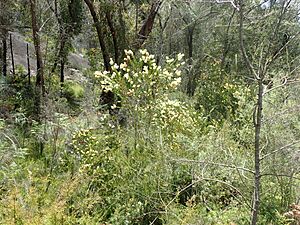Lemon bottlebrush facts for kids
Quick facts for kids Lemon bottlebrush |
|
|---|---|
 |
|
| Melaleuca pallida leaves and flowers | |
| Scientific classification | |
| Genus: |
Melaleuca
|
| Species: |
pallida
|
The Melaleuca pallida, often called lemon bottlebrush, is a plant from the Myrtaceae family, which includes myrtles. It grows only in eastern Australia. (Some plant experts in Australia still use the name Callistemon pallidus for it.) This plant is an upright shrub with thin, spreading branches. Its new leaves are silvery, and its flowers are pale yellow, sometimes with a hint of pink, shaped like a bottlebrush.
Contents
What Does the Lemon Bottlebrush Look Like?
The lemon bottlebrush can be a shrub or a small tree, growing up to about 8 m (30 ft) tall. It has bark that feels like paper or is stringy. Its leaves grow one after another along the stem. They are usually 20–79 mm (0.8–3 in) long and 4–17 mm (0.2–0.7 in) wide. The leaves are flat or slightly V-shaped, narrow at the base, and have a small point at the tip. You can see a clear main vein, some faint side veins, and many tiny oil glands on the leaves.
The flowers are usually cream to yellow, but sometimes they can be pinkish-red. They grow in spikes at the ends of branches, which keep growing even after the flowers bloom. Sometimes, flowers also appear on the sides of the branches. These flower spikes are about 20–45 mm (0.8–2 in) across and have 15 to 50 individual flowers. Each flower has petals that are 2.9–6 mm (0.1–0.2 in) long and fall off as the flower gets older. There are also 34 to 70 stamens (the parts that hold pollen) in each flower. The lemon bottlebrush blooms from October to February. After flowering, it produces woody, cup-shaped seed pods called capsules, which are 3.9–6.6 mm (0.2–0.3 in) long.

How Did It Get Its Name?
The lemon bottlebrush was first officially described in 1816 by a scientist named Aimé Bonpland. He named it Metrosideros pallida. Later, in 1828, de Candolle changed its name to Callistemon pallidus. Then, in 2006, Lyndley Craven changed it again to Melaleuca pallida. The word pallida comes from Latin and means "pale," which describes the light color of its flowers.
Some plant experts, like those at the Royal Botanic Gardens, Kew, consider Callistemon pallidus to be the same plant as Melaleuca pallida.
Where Does It Grow?
The Melaleuca pallida grows in various parts of eastern Australia. You can find it from the Border Ranges area in southeastern Queensland, through the mountains and slopes of New South Wales, and into eastern Victoria. It also grows in most parts of Tasmania and on some islands in the Bass Strait. This plant prefers to grow near streams and on wet, rocky slopes.
Growing Lemon Bottlebrush at Home
People sometimes grow Melaleuca pallida in their gardens, often calling it Callistemon pallidus. It's a tough plant that can grow in many different types of soil. However, it needs plenty of sunshine to thrive.
Gallery
-
M. pallida growing near wet heath in the Gibraltar Range




